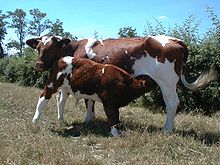Мэн-Анджу
 Корова и теленок | |
| Статус сохранения | ФАО (2007): никаких забот [ 1 ] : 144 |
|---|---|
| Другие имена |
|
| Страна происхождения | Франция |
| Распределение | |
| Использовать | ранее двойное назначение, теперь в основном для говядины |
| Traits | |
| Weight | |
| Height | |
| Coat | red pied |
| Horn status | horned in both sexes[3] |
| |
Maine -Anjou -это французская порода домашнего крупного рогатого скота, выращенная в основном в регионе De La Loire на северо-западе Франции. Он был создан в девятнадцатом веке в исторической провинции Мэн путем перекрестного размножения местного молочного скота из Манселле с запасом Дарема из Великобритании и сначала назывался Дарем-Манселл . Во Франции он был известен с 2004 года как Rouge des Prés , но имя Maine-Anjou продолжает использоваться в другом месте. Раньше это было животное с двойным назначением, выращенное как для мяса, так и для молока, но теперь это в основном порода говядины.
История
[ редактировать ]Порода штата Мэн-Анджу была создана в девятнадцатом веке владельцами крупных поместий в традиционной провинции штат Мэн , которые скрещивают местный молочный скот из Манселле с британским скотом Дарема-порода, которая впоследствии станет шортхорном . [ 2 ] : 236 Полученная порода двойного назначения была изначально известна как Дарем-Мансел. Стадо было начато в 1908 году, и название породы было изменено на Мэн-Анджу. Это было снова изменено в 2004 году, на Rouge des Prés, но за пределами Франции более старое имя продолжает использоваться. [2]: 236 From about 1970, breeding favoured beef production over dairy use. The Maine-Anjou may display the genetic myostatin deficiency which produces "double muscling", but has not been selectively bred for this attribute.[2]: 236
The Maine-Anjou is reported from eight countries in the world, with an estimated total population of about 60000, of which approximately two thirds are in France.[4] Of these, some 90% are in the Pays de la Loire, and most of the remainder in the neighbouring Basse-Normandie and Poitou-Charentes regions.[2]: 236 About one third of the world population is in the United States, where registrations began in 1969.[2]: 236
Use
[edit]The Maine-Anjou was created as a dual-purpose breed, for both beef and milk. Since about 1970 it has been raised predominantly for beef. Maine-Anjou beef from Rouge des Prés cattle raised in the départements of the Deux-Sèvres, the Ille-et-Vilaine, the Loire-Atlantique, the Maine-et-Loire, the Mayenne, the Orne, the Sarthe and the Vendée received Appellation d'Origine Protégée status in 2010.[5]
References
[edit]- ^ Barbara Rischkowsky, D. Pilling (eds.) (2007). List of breeds documented in the Global Databank for Animal Genetic Resources, annex to The State of the World's Animal Genetic Resources for Food and Agriculture. Rome: Food and Agriculture Organization of the United Nations. ISBN 9789251057629. Accessed November 2016.
- ^ Jump up to: a b c d e f g h i Valerie Porter, Lawrence Alderson, Stephen J.G. Hall, D. Phillip Sponenberg (2016). Mason's World Encyclopedia of Livestock Breeds and Breeding (sixth edition). Wallingford: CABI. ISBN 9781780647944.
- ^ Rouge des prés/France. Domestic Animal Diversity Information System of the Food and Agriculture Organization of the United Nations. Accessed November 2016.
- ^ Transboundary breed: Maine-Anjou. Domestic Animal Diversity Information System of the Food and Agriculture Organization of the United Nations. Accessed November 2016.
- ^ [s.n.] (21 December 2010). La viande Maine Anjou obtient l'Appellation d'Origine Protégée (AOP) (in French). La Dépêche du Midi.
![]() Media related to Maine-Anjou cattle at Wikimedia Commons
Media related to Maine-Anjou cattle at Wikimedia Commons